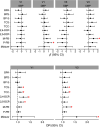Association of Phenols, Parabens, and Their Mixture with Maternal Blood Pressure Measurements in the PROTECT Cohort
- PMID: 39140735
- PMCID: PMC11323763
- DOI: 10.1289/EHP14008
Association of Phenols, Parabens, and Their Mixture with Maternal Blood Pressure Measurements in the PROTECT Cohort
Abstract
Background: Phenols and parabens are two classes of high production volume chemicals that are used widely in consumer and personal care products and have been associated with reproductive harm and pregnancy complications, such as preeclampsia and gestational diabetes. However, studies examining their influence on maternal blood pressure and gestational hypertension are limited.
Objectives: We investigated associations between individual phenols, parabens, and their mixture on maternal blood pressure measurements, including systolic and diastolic blood pressure (SBP and DBP) and hypertension during pregnancy (defined as stage 1 or 2 hypertension), among Puerto Rico PROTECT study participants.
Methods: We examined these relationships cross-sectionally at two time points during pregnancy (16-20 and 24-28 wks gestation) and longitudinally using linear mixed models (LMMs). Finally, we used quantile g-computation to examine the mixture effect on continuous (SBP, DBP) and binary (hypertension during pregnancy) blood pressure outcomes.
Results: We observed a trend of higher odds of hypertension during pregnancy with exposure to multiple analytes and the overall mixture [including bisphenol A (BPA), bisphenol S (BPS), triclocarbon (TCC), triclosan (TCS), benzophenone-3 (BP-3), 2,4-dichlorophenol (2,4-DCP), 2,5-dichlorophenol (2,5-DCP), methyl paraben (M-PB), propyl paraben (P-PB), butyl paraben (B-PB), and ethyl paraben (E-PB)], especially at 24-28 wk gestation, with an adjusted mixture (95% CI: 1.03, 2.38). Lower SBP and higher DBP were also associated with individual analytes, with results from LMMs most consistent for methyl paraben (M-PB) or propyl paraben (P-PB) and increased DBP across pregnancy [adjusted M-PB (95% CI: 0.17, 1.38) and adjusted P-PB (95% CI: 0.19, 1.51)] and for BPA, which was associated with decreased SBP (adjusted ; 95% CI: , ). Consistent with other literature, we also found evidence of effect modification by fetal sex, with a strong inverse association observed between the overall exposure mixture and SBP at visit 1 among participants carrying female fetuses only.
Conclusions: Our findings indicate that phenol and paraben exposure may collectively increase the risk of stage 1 or 2 hypertension during pregnancy, which has important implications for fetal and maternal health. https://doi.org/10.1289/EHP14008.
Figures

References
-
- Chen WJ, Robledo C, Davis EM, Goodman JR, Xu C, Hwang J, et al. 2022. Assessing urinary phenol and paraben mixtures in pregnant women with and without gestational diabetes mellitus: a case-control study. Environ Res 214(pt 2):113897, PMID: 35839910, 10.1016/j.envres.2022.113897. - DOI - PMC - PubMed
MeSH terms
Substances
Grants and funding
LinkOut - more resources
Full Text Sources
Miscellaneous

